Because meat is what men eat…

See also this BEEF! BEEF! BEEF! Campbell’s Soup ad.
From MultiCultClassics.
—————————
Lisa Wade is a professor of sociology at Occidental College. You can follow her on Twitter and Facebook.
Because meat is what men eat…

See also this BEEF! BEEF! BEEF! Campbell’s Soup ad.
From MultiCultClassics.
—————————
Lisa Wade is a professor of sociology at Occidental College. You can follow her on Twitter and Facebook.
I could make some sociological comment about the linking of the marketing for Easter candy and professional wrestling… but really I just think this is hilarious. Not only is it a linking of the marketing of Easter candy and professional wrestling (go, Jesus, go?), but there is something so wrong (or is it so right?) about the proximity of the words “EGG” and “RAW” (NOT appetizing) and also the phrase “Jelly-filled mallows” (so soft and sweet!) next to the ripped, muscle-bound dude in the middle. I couldn’t make this stuff up.
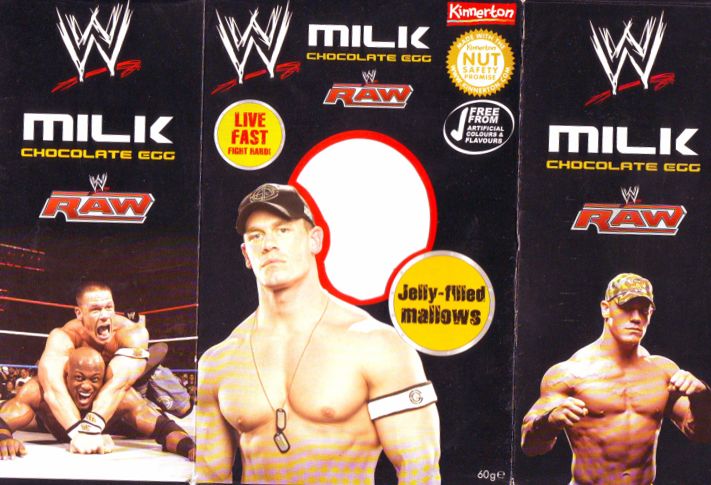
Also in wrestling: No Nipples Allowed!!!
(Image at CMM News.)
We’re pleased to feature a post by Robert Hariman. Robert is a professor of Rhetoric and Public Culture in the Department of Communication Studies of Northwestern University. Robert blogs at No Caption Needed, where we saw this great post:
—————————
I am suspicious of references to “the Arab Street,” particularly when the phase is applied–as it often is–to nations and other vast swaths of territory that are not Arab or not exclusively Arab. Several years ago Christopher Hitchens declared that it was a vanquished cliche but he was misusing it himself and not surprisingly as he was blowing the war trumpet for the Bush administration. And he wasn’t speaking of its persistence as a visual convention.
The caption of this photograph at The Guardian says only, “Nowruz celebrations in Afghanistan.” Nowruz is the name of the Iranian New Year, which is celebrated in a number of countries by people of several faiths. The baskets of dried fruits eaten during the holiday provide the only visual connection to the colorful festivities, and you have to know more than the paper tells you to see that. For many viewers, this will a thoroughly conventional image of the Middle East.
That image is one of throngs of working class men massed together in the street. What little business is there is in the open air markets lining each side of the densely packed urban space. We see small batches of everyday goods on display–probably to be bartered for, no less. The open baskets of food are a sure marker of the underdeveloped world. (Imagine how many packages it would take to wrap up all that fruit for individual snacks to be sold in the US; and even in Whole Foods the unpackaged food is in closed bins.) Everything fits together into a single narrative, but the masses of men and boys make the scene politically significant. This is the place where collective delusions take hold, where mobs are formed, and where unrest can explode into revolutionary violence and Jihad.
Which is why I get a kick out of this photograph of another Nowruz celebration.
The caption reads, “An Iranian man skewers chicken for grilling as he picnics with his family.” My first thought when I saw the image was to check and make sure it wasn’t taken in Chicago. This also is a very familiar scene: grass, blankets, families and friends, plastic containers of food, dad getting ready to do the grilling.
What is astonishing is that I was able to see them at all. A typical summer holiday photo becomes a radical disruption of Western visual conventions when taken in Iran and shown in the US. Of course, it wasn’t shown in the US: this, too, is from the UK paper.
In this photo, there is no Arab street nor Iranian masses dominated by Mullahs and demagogues. A middle class tableau reveals that so much of what is in fact ordinary life for many people in Iran and elsewhere in the Middle East is never seen in the US. And it isn’t seen because it doesn’t fit into simplistic categories, outdated stereotypes, and a dominant ideology. All that is shown and implied in the cliches is of course also there, but it is there as part of a much more complex and varied social reality.
As evidence of how things might appear a bit different, notice how seeing the second image can affect perception of the first one. In the second, it seems evident that the family is posing for the photograph. They’re doing exactly what they would have been doing but now with the additional, amused awareness that it is, for a moment, also an act. And sure enough, if you look back to the first photo, you can see the same thing. And if you can see that, they no longer need appear as a mass, or poor, or threatening, or anything but people enjoying a holiday. Much like people in the US were doing this past weekend to celebrate St. Patrick’s day, thronged together, in the street.
Photographs by Natalie Behring-Chisholm/Getty Images and Behrouz Mehri/AFP-Getty Images.
February is Black History Month, the month in which companies tout their support for the Black community. MultiCultClassics, a blog that focuses on company outreach to people of color as employees and consumers, has been asking some interesting questions about this phenomenon. Cynically, perhaps, it is suggested that it is all a big marketing scheme aimed at a good 13 percent of the American population. Hmmmm. For example:
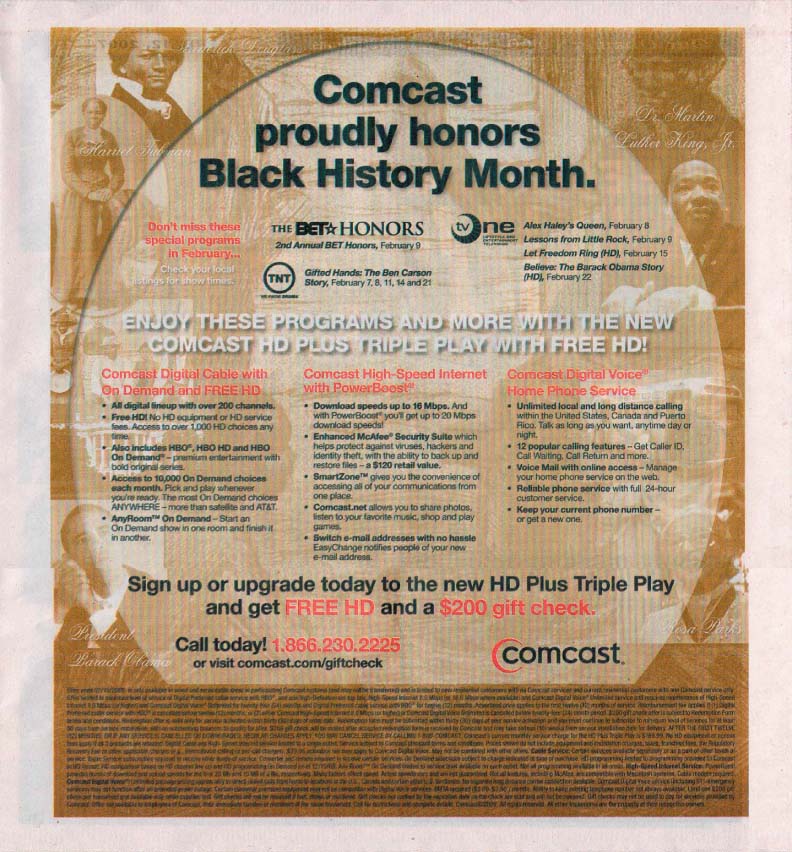
This message was appearing on the screens at a grocery store…

…and HighJive decided to test the theory. The blogger went to the grocery store website, searched for information regarding “Black History Month,” and found only this:
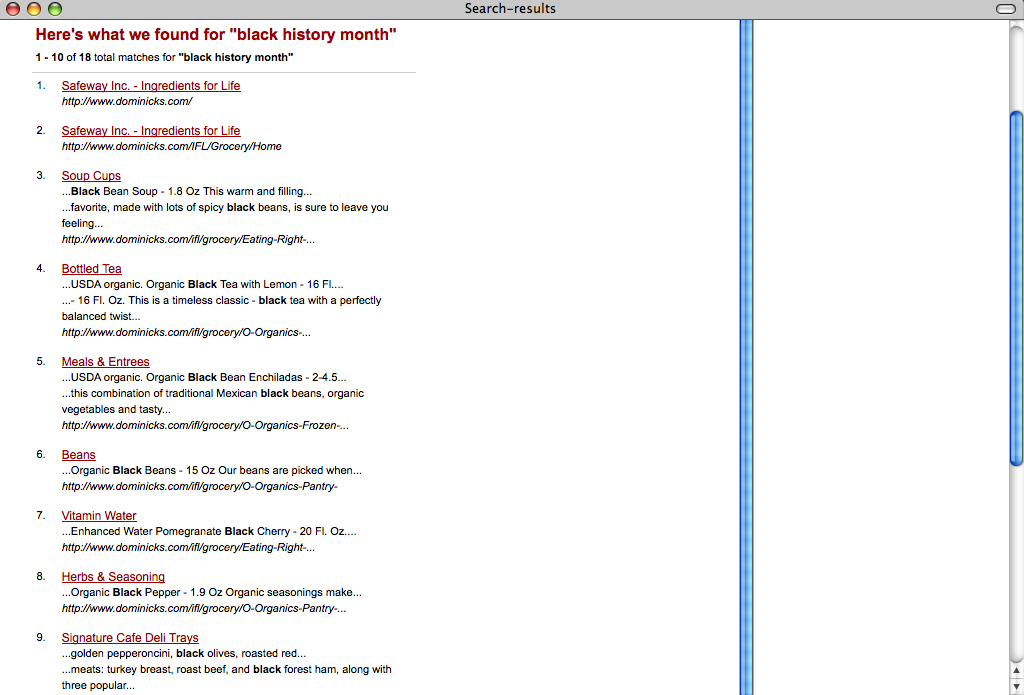
(Post here.)
Way back in 1703, French settlers in Mobile, Alabama – at the time, the capital of French Louisiana and not much more than a tiny settlement attached to Fort Louis de la Mobile – decided to celebrate Shrove Tuesday with a feast and a party. Over the next few years, the celebrations grew more elaborate, with the first known parade taking place in 1711: the Boeuf Gras (“fatted ox”) society put together a large papier mache cow’s head and rolled it through town on a cart, which I’m sure made a lot of sense at the time.
(It is at this point that native Mobilians, like myself, like to point out that New Orleans wasn’t even founded until 1718, and that New Orleans’ oldest continually-parading organization, the Mistick Krewe of Comus, was founded by six guys from Mobile. Ahem.)
And so today we celebrate Fat Tuesday – the last hurrah before Lent – by dressing up in funny clothes, drinking to excess, dancing in the streets, and hurling moonpies at each other. To celebrate, I thought I’d share an interesting symbol and recommend an excellent documentary film on Mobile Mardi Gras, director Margaret Brown’s The Order of Myths.
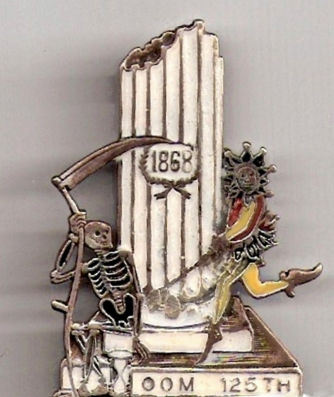
What we have here is Folly chasing Death around a broken Ionic column, while whacking Death with gilded pig bladders; seeing as how during Mardi Gras the normal social order is overturned, why not the natural order as well? Here’s a similar image from a float:

To me, these images sum up a lot of what’s great about Mardi Gras: it’s a finger in the eye of mortality and a celebration of a kind of genial lunacy. But what about that Ionic column? Well, the decoding gets a little stickier there.
I’ve heard a couple of different explanations: one is that the column represents time, the other that it represents the Confederacy or the Old South more generally. It gets a little more complicated when you look at it in context: this particular image is the emblem float of the Order of Myths, and is pulled by donkeys mules and lit by gaslight lamps – which are carried by young African-American men – in the same manner it has been since the founding of the organization shortly after the Civil War. Mobile’s mystic societies, you see, remain firmly segregated, which brings me to Margaret Brown’s excellent film.
Brown – whose first full-length documentary, Be Here To Love Me, is an excellent if crushingly depressing film about Texas songwriter Townes Van Zandt – is a fellow Mobile expat, and her film examines the complexities of race, class, and collective memory in Mobile as embodied in the 2007 Mardi Gras season. She focuses primarily on the two parallel Mardi Gras courts and documents some tentative steps toward integrating the two. I won’t say much more, for fear of spoiling the film for you, except to remark that the past is very much present in the film, in ways that both William Faulkner and Pierre Bourdieu would appreciate. And I’d also add that Brown eschews a heavy-handed or didactic approach in favor of laying the situation out for the viewer and letting them draw their own conclusions, with a few subtle editorial decisions and one late-in-the-game revelation that throws much of the previous hour and a half into a new and intriguing light. Here’s a trailer for the film:
My only real criticism of The Order of Myths is that Brown focuses primarily on the Mardi Gras elite – a little of Joe Cain Day (held the Sunday before Fat Tuesday and known as “the People’s Parade” because pretty much anybody can be in it if they can get a slot) would have gone a long way: class in Mobile is not quite coterminous with race, after all. There’s a lot more to Mobile Mardi Gras than the royal courts, and we don’t really get to see much of that. Similarly, the school featured in the film is more integrated than you’d think, as are the crowds along the parade routes, given what’s shown in the film.
But these are relatively minor points – by and large, Brown tackles the subject with a keen and incisive eye, and I’d highly recommend it to anyone teaching a class on race in the United States.
———————-
For the record, the title of the post translates as “time flies, remember you are mortal, party on.”
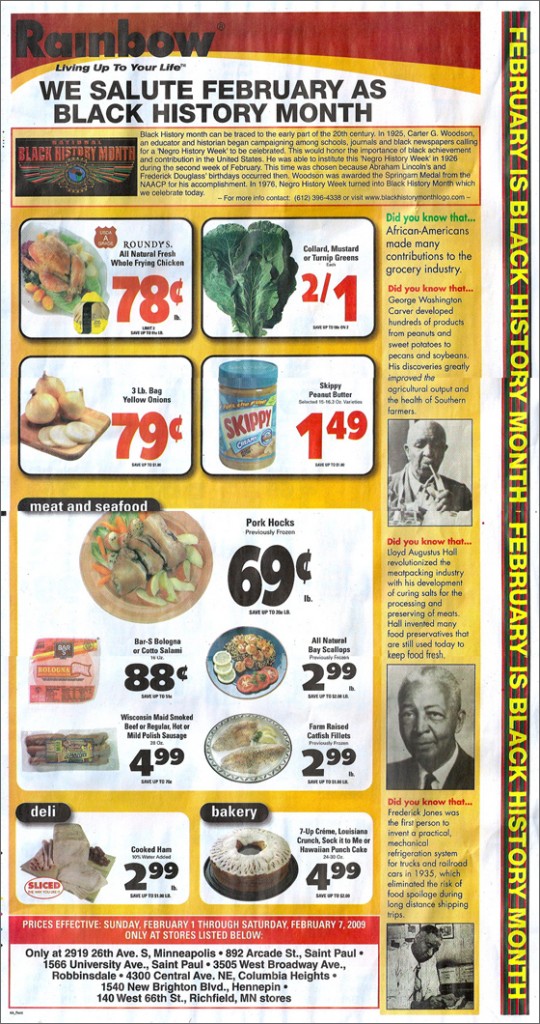
Gawker, via Copyranter.
A Daily Mail story reports that women lawyers are being told by “image consultants’ that to appear “professional” they should enhance their femininity by wearing skirts and stilettos, but avoid drawing attention to their breasts. Thoughts about the word “professional” after the screenshot (thanks to Jason S. for the link):
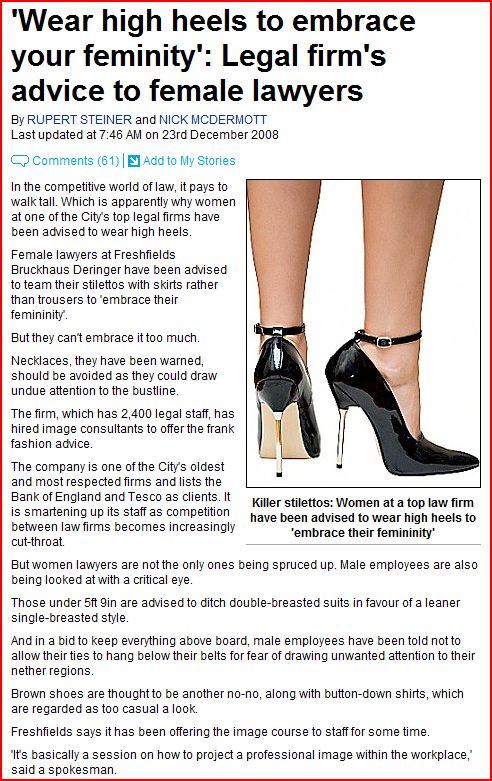
A spokesman for the company doling out this advice says that it’s about being “professional.” This is a great term to take apart. What do we really mean when we say “professional”?
How much of it has to do with proper gender display or even, in masculinized workplaces, simply masculine display?
How much of it has to do with whiteness? Are afros and corn rows unprofessional? Is speaking Spanish? Why or why not?
How much of it has to do with appearing attractive, heterosexual, monogamous, and, you know, not one of those “unAmerican” religions?
For that matter, how much of it has to do with pretending like your work is your life, you are devoted to the employer, and your co-workers are like family (anyone play Secret Santa at work this year)?
What do we really mean when we say “professional”? How does this word get used to coerce people into upholding normative expectations that center certain kinds of people and marginalize others?
Ben O. brought our attention to a series of sexist ads for Griffen Microsheen boot polish. Here’s one for your Christmas viewing pleasure:
I’m sure Santa was pleased that he could see her nipples through her nightie.
Lots more Microsheen ads at Found in Mom’s Basement.
Thanks, Ben!